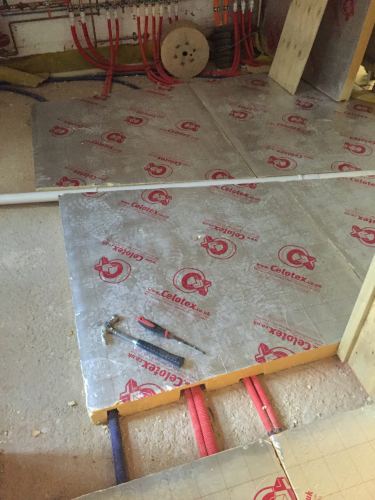Solid floor insulation
Solid floors, such as concrete or screed generally lose less heat than suspended floors. They can still be insulated by laying a new layer of rigid insulation on top. This is then usually covered by chipboard and your desired floor covering. The insulation can be placed directly above the existing concrete or screed in the form of a ‘floating’ floor. This method will raise the floor level, so skirting boards may need to be refitted and doors will need to be trimmed. It may also be necessary to adapt thresholds.
In a typical dwelling 60% of the energy used is for space heating and a large amount of this can be lost through floors. Whilst the actual amount of heat lost through a solid floor is less than for modern suspended floors (as a result of both the buffering effect of the thermal mass and its insulating effect), still there are potential significant energy savings to be gained from insulating solid flooring.
The cost of solid floor insulation can range considerably depending on the size of your home and the retailer you purchase it from.
Listed Building Consent is required for insulation of solid floors.
Where there are significant, undisturbed, historic floor surfaces the character and interest could be harmed from being lifted, and therefore installing insulation is unlikely to be acceptable. However where there this is not the case (such as where there is a poor quality modern, replacement surface material or there is convincing evidence that a historic floor has been previously lifted and re-laid), the installation of underfloor heating may be possible. In which case limecrete should be used which can be used in conjunction with insulation and under floor heating systems, whilst allowing the transfer of moisture.
Example of solid floor insulation with under floor heating
Breathable materials should be used to maintain the passage of moisture and air.
Work should be undertaken by a suitably experienced and qualified professional.
We support careful insulation of solid ground floors where there is no detrimental impact on the architectural or historic interest of the building, including any archaeological features.
In the light of the Climate Emergency, we will generally permit and encourage alterations on listed buildings, with special regard to the the following:
- Preserving the building, its setting or any features of special architectural or historic interest which it possesses
- Preserving or enhancing the character of a conservation area
- Respecting the significance of any non-designated heritage asset
Insulating Solid Ground Floors from Historic England


